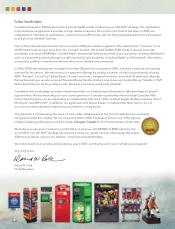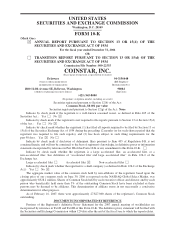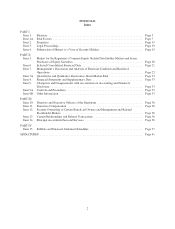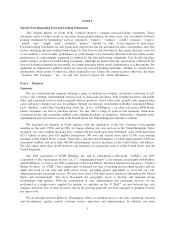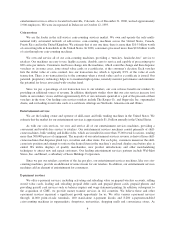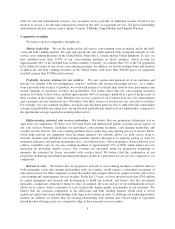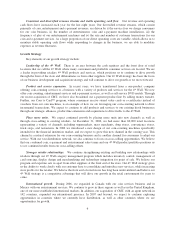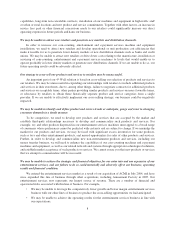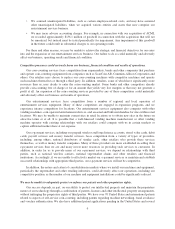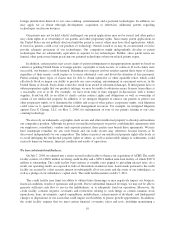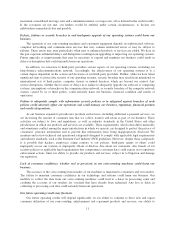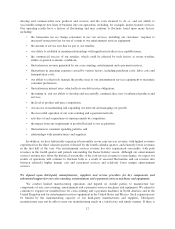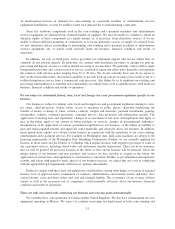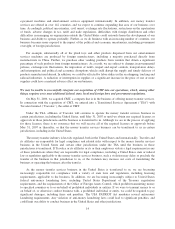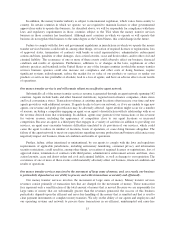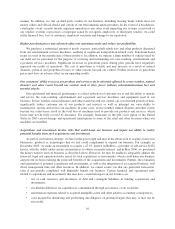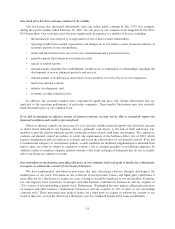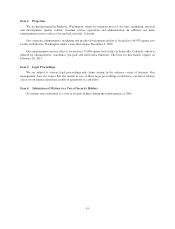Redbox 2006 Annual Report Download - page 12
Download and view the complete annual report
Please find page 12 of the 2006 Redbox annual report below. You can navigate through the pages in the report by either clicking on the pages listed below, or by using the keyword search tool below to find specific information within the annual report.foreign jurisdictions directed to our coin-counting, entertainment and e-payment technologies. In addition, we
may apply for or obtain (through development, acquisition or otherwise) additional patents regarding
technologies used in our business.
Our patents may not be held valid if challenged, our patent applications may not be issued, and other parties
may claim rights in or ownership of our patents and other proprietary rights. Since many patent applications in
the United States are not publicly disclosed until the patent is issued, others may have filed applications, which,
if issued as patents, could cover our products or technology. Patents issued to us may be circumvented or fail to
provide adequate protection of our technologies. Our competitors might independently develop or patent
technologies that are substantially equivalent or superior to our technologies. Further, since patent terms are
limited, other parties may begin practicing our patented technologies when our related patents expire.
In addition, certain parties may assert claims of patent infringement or misappropriation against us based on
current or pending United States or foreign patents, copyrights or trade secrets, or contracts. If such claims were
successful, our business could be harmed. Defending our company and our retailers against these types of claims,
regardless of their merits, could require us to incur substantial costs and divert the attention of key personnel.
Parties making these types of claims may be able to obtain injunctive or other equitable relief, which could
effectively block or impair our ability to provide our coin-counting, entertainment or e-payment services, in the
United States or abroad. Such claims could also result in an award of substantial damages. If third parties have or
obtain proprietary rights that our products infringe, we may be unable to obtain necessary licenses from others at
a reasonable cost or at all. For example, we have from time to time engaged in discussions with a former
supplier, ScanCoin AB, in an effort to clarify certain contract rights and obligations as well as ownership of
certain of our intellectual property. In addition, if we instigate litigation to enforce our patents or protect our
other proprietary rights, or to determine the validity and scope of other parties’ proprietary rights, such litigation
could cause us to spend significant financial and management resources. For example, we instigated litigation
against Coin X Change, LLC, on May 2, 2006, for infringement of four of our patents relating to our coin-
counting technology.
We also rely on trademarks, copyrights, trade secrets and other intellectual property to develop and maintain
our competitive position. Although we protect our intellectual property in part by confidentiality agreements with
our employees, consultants, vendors and corporate partners, these parties may breach these agreements. We may
have inadequate remedies for any such breach and our trade secrets may otherwise become known or be
discovered independently by our competitors. The failure to protect our intellectual property rights effectively or
to avoid infringing the intellectual property rights of others, as well as unfavorable rulings or settlements, could
seriously harm our business, financial condition and results of operations.
We have substantial indebtedness.
On July 7, 2004, we entered into a senior secured credit facility to finance our acquisition of ACMI. The credit
facility consists of a $60.0 million revolving credit facility and a $250.0 million term loan facility, of which $187.0
million is outstanding. The credit facility bears interest at variable rates pegged to prevailing interest rates. As a
result, our operating results are exposed to risks of fluctuations in interest rates. Loans made pursuant to the credit
facility are secured by a first security interest in substantially all of our assets and the assets of our subsidiaries, as
well as a pledge of our subsidiaries’ capital stock. The credit facility matures on July 7, 2011.
This credit facility may limit our ability to obtain future financings or may negatively impact our business,
financial condition, results of operations and growth. Due to substantial financial leverage, we may not be able to
generate sufficient cash flow to service the indebtedness, or to adequately fund our operations. Moreover, the
credit facility contains negative covenants and restrictions relating to such things as certain common stock
repurchases, liens, investments, capital expenditures, indebtedness, cash payments of dividends, and fundamental
changes or dispositions of our assets that could impair our flexibility to pursue growth opportunities. In addition,
the credit facility requires that we meet certain financial covenants, ratios and tests, including maintaining a
10


